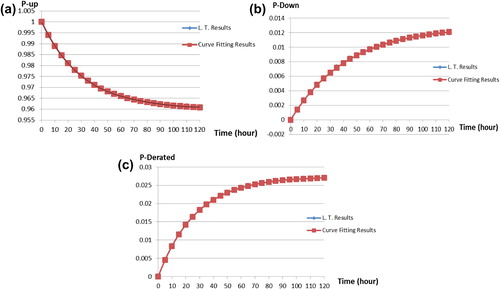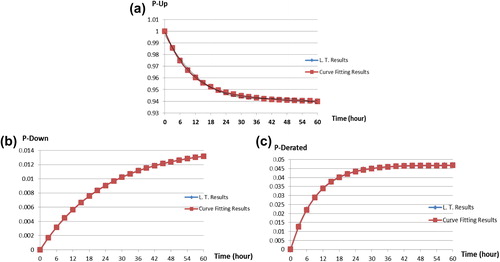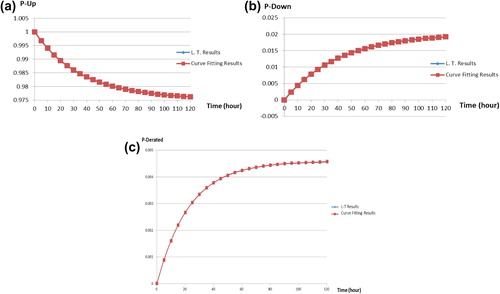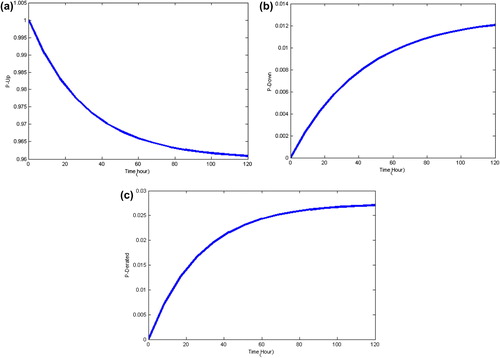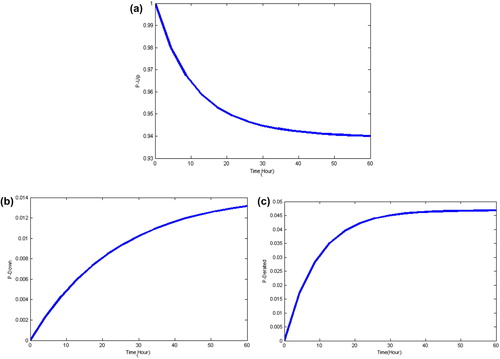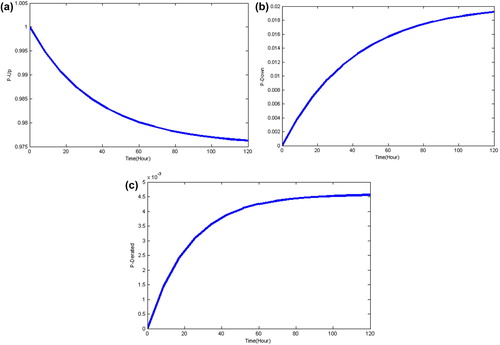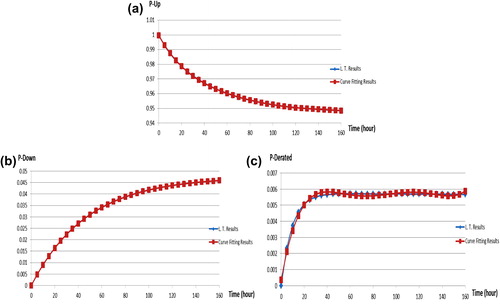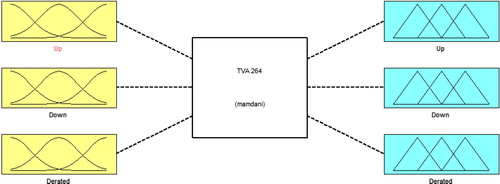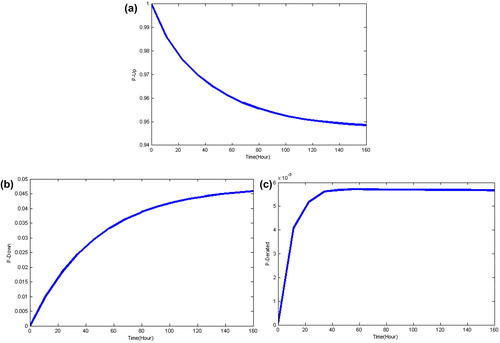Abstract
In the present paper, the numerical evaluation of Markov model transient behavior is considered. It is focused on finding the transient-state probabilities of well-known four Tennessee Valley Authority (TVA) models. Three computational approaches are examined to find the three transient probabilities after modeling. These approaches are the Laplace Transforms, curve fitting and Neuro-Fuzzy. The MATLAB Simulink 7.10 package is used to obtain the transient state-probabilities for the four TVA models and at the same interval of time these solutions are reproduced by Laplace Transforms. For each model the three-state probabilities of the TVA models are derived. Each model is considered as a 3-state model, where its equations are obtained using the curve fitting and Neuro-Fuzzy techniques. All techniques used and applied in the present study are used to formulate and obtain the TVA models, where the Laplace Transforms is re-derived and re-used for a double check to model and obtain the results.
1 Introduction
The Tennessee Valley Authority (TVA, Citation2013) is a corporation owned by the United States Government. The TVA provides electricity for 9 million people in parts of seven southeastern states. The TVA receives no taxpayer money and makes no profits. It should be highlighted that TVA renewed its vision to help lead the Tennessee Valley region and the nation toward a cleaner and more secure energy future. At the moment, TVA is considered as new green power providers program contributors to TVA’s expanding renewable energy.
CitationBiggerstaff et al. (1969) presented a method showing the Markov process to determine the state probabilities of generating units as functions of time. In CitationBiggerstaff et al. (1969) study, the considered four three-state TVA models were restricted to three states; where the first is operating at full capability, the other is operating at less than the full capability due to component outages (known as derated state) and the last is then forced out. The state probability functions are calculated using the Laplace Transforms. The initial probabilities are considered for the operation at full capability to be unity and the other two states are zeros. CitationChen et al. (2013) used the Genetic Algorithm (GA) to estimate the battery model parameters including the diffusion capacitance in real time using measurement of current and voltage of the battery. The conclusion was made from the simulation and experiment results for their research. CitationKim et al. (2013) carried out the study of the dynamic characteristics of a solar cell that can rarely be found. In the study, an AC impedance model of a solar cell module was developed using impedance Spectroscopy and it is then used for evaluating the effects of the ripple current generated by a single-phase inverter. In CitationQamber and Fakhro (1994) the Laplace Transforms re-derived again, because it is found that CitationBiggerstaff et al. (1969) failed to detect a mathematical flaw. CitationQamber and Fakhro (1994) derived the three state general formulas for both steady state and transient probabilities. The formulas derived in CitationQamber and Fakhro (1994) can be applied to any Markov model and is independent of matrix manipulations. CitationYan and Chowdhury (2013) presented a hybrid midterm electricity market clearing price forecasting model combining both squares support vector machine and auto-regressive moving average with external input modules. The proposed model in the study showed improved forecasting accuracy compared to a forecasting model using a single least squares support vector machine. In the proposed Fuzzy Back-Propagation Neural Network (FBPNN) by CitationTripathy et al. (2008) which is used as a core classifier to discriminate between magnetizing inrush and internal fault of a power transformer, a three-layered structure is used. An optimal number of neurons in the hidden layer as well as in the output layer were used by developing an algorithm. The developed technique is simple in architecture, fast in operation, and quite reliable. The proposed study by CitationQamber and Al-Gallaf (2001) presents a class of week series forecasting manner. The class is based on the Fuzzy Inference Clustering (FIC) method along with Artificial Neural Network (ANN) which was employed in the extent of long-term electric load forecasting. The employed fuzzy clustering algorithm is useful also for linguistic modeling of an electric power demand used for higher hierarchy decision system. The study was carried out on normal and abnormal days.
CitationMaurya (2014) demonstrates mathematical modeling and evaluation of performance measures of k-out-of-n repairable system wherein the most influencing constraints of human error and common-cause failure have been taken into consideration. Laplace Transforms of various state probabilities are found.
CitationLydia et al. (2014) present the wind turbine curve showing the relationship between the wind turbine power and hub height wind speed. Accurate models of power curve serve as an important tool in wind power forecasting. Wind Turbine Power Curve (WTPC) has been modeled using polynomial expressions of varied orders in different literatures.
CitationBisht and Jangid (2011) used Adaptive Neuro-Fuzzy Inference System (ANFIS) and Linear Regression (MLR) methods. The objective of the paper is to investigate the best model to forecast river discharge. The developed models in the study were trained, tested and validated on the data of the river using Neuro-Fuzzy modeling. It is well known that the Neuro-Fuzzy is a marriage between neural networks and fuzzy logic techniques. MATLAB was used for modeling ANFIS to solve real-world forecasting, classification and function approximation problems. In the study, the results obtained are compared to Multiple Linear Regression models.
2 Modeling
In the present article, the curve-fitting and Neuro-Fuzzy techniques are applied to get the models for four 3-state models of TVA. To get the four models of each TVA system, the curve-fitting technique is applied at the beginning. Before that, the TVA models have to be defined. Each model of TVA has three-states. These three-state models for the TVA models are considered as follows:
S1: System operates at full capacity and defined as Up-State
S2: System fails, where no power at all is generated and known as Down-State
S3: System operates at less than full capacity due to generator outages and known as De-rated State.
Each model of the 3-state TVA models can be represented by .
As a Markov model, can be represented in the following Matrix form:where the symbols a, b, c, d, e and f are the transition rates of each TVA four models. These transition rates for the four TVA models are extracted from CitationBiggerstaff et al. (1969) and given in .
Table 1 Transition rates of the four TVA models.
The general formulas of state-probabilities for each 3-State TVA model can be formed as a differential equation which is the rate of change of each state-probability with the rate of change of time. The general equations are:(1)
(2)
(3) The above three equations are solved to calculate the transient solution which helps to find the transient three state probabilities. There are a number of methods to obtain the solution.
3 Results of TVA modeling using L.T. and curve fitting
As mentioned earlier, there are a number of methods used to calculate the transient probabilities. One of which is the Laplace Transforms method which obtains the transient state probabilities of the 3-State TVA models given in CitationQamber and Fakhro (1994). The initial probabilities for each model are P1 (0) = 1, P2 (0) = 0 and P3 (0) = 0. The results are obtained from the four TVA models.
The curve fitting modulation in the MATLAB package is used to obtain models of the four 3-state TVA models after reproducing the results using the (L.T.). The produced results in Tables (2–5) are used to obtain the following equations using the curve fitting technique:
| (i) | TVA1: | ||||
| (ii) | TVA2: | ||||
| (iii) | TVA3: | ||||
| (iv) | TVA4: | ||||
Based on the above models for the four 3-State TVA models using the MATLAB, the results are calculated and plotted with the existing data (results calculated using both the Laplace Transforms and Curve Fitting techniques) for TVA models. The plotted results are shown in – which represent the four 3-state TVA models.
It should be highlighted that all equations have been obtained using the polynomial, where in references CitationBiggerstaff et al. (1969) and CitationQamber and Fakhro (1994) the results are obtained using the (L.T.) and reproduced again using the (L.T.) in this research. Based on the results obtained and plotted in –, it is clear that the L.T. results and curve fitting results are almost identical, except those in c which are almost close to each other.
4 Neuro-Fuzzy modeling
Neural networks are used to tune membership functions of fuzzy systems that are employed as decision-making systems for controlling equipment. The Neuro-Fuzzy system is a system that has a combination of advantages of the neural networks and fuzzy logic. It was noted that neural networks have two main benefits, where in reference CitationCarpenter et al. (1993). First, they are capable of learning non-linear mappings of numerical data. Second, they perform parallel computation. However, the operation of neural networks has also many weaknesses. Therefore, it is very hard to understand the meaning of weights, and the incorporation of prior knowledge into the system is usually impossible.
In addition, Neuro-Fuzzy systems allow incorporation of both numerical and linguistic data into the system. The Neuro-Fuzzy system is also capable of extracting fuzzy knowledge from numerical data.
The general model for the Neuro-Fuzzy system is shown in which illustrates the five layer connection for two inputs and one output. These five layers represent the Neuro-Fuzzy model which will be used to represent the TVA model used above.
The proposed model using the Neuro-Fuzzy is a three inputs and three outputs model which is shown in . The number of member states used for this model is either 6-member states to represent the Higher and Lower limits of each state of the TVA model or 9-member states to represent the Higher, Average and Lower limit of each state of the TVA model. The plotted results are illustrated in which represent the four 3-state TVA models using the Neuro-Fuzzy method.
5 Discussion
In the present paper, three technical novelty techniques are proposed. They have increased performance in terms of execution time. These techniques are Laplace Transforms, curve-fitting and Neuro-Fuzzy.
The main objective of the present study is to re-model the transient state probabilities of the four TVA models and to find as well the best models for the TVA even though, many researchers worked on the modeling using the curve fitting and other methods. TVA data are very useful in the modeling of a three-state model system. In the present work, the Neuro-Fuzzy is studied and used. It is found that it is the most useful and best in the present study to model and calculate the transient probabilities. The performances of the TVA models are clear.
To calculate the transient probabilities throughout the operation period, probability of each TVA model trained in any instance of time to develop IF–THEN fuzzy rules which help in determining the membership functions input and output variables of the TVA model.
From the obtained results using the Neuro-Fuzzy () when compared with the results obtained applying the models of the curve-fitting (), it is clear that they are almost identical except c which is more accurate when compared with c. The output of using the Neuro-Fuzzy (c) is more accurate and smooth.
In the present study, it is clear that the combination of fuzzy logic and neural network (becoming Neuro-fuzzy) constitutes a powerful means for designing intelligent systems and accurate results obtained.
In the present study both the curve fitting and Neuro-Fuzzy techniques were adopted and applied to the four TVA models to calculate the transient state probabilities of the models. The performance of both techniques was also evaluated to obtain the available and accurate technique for the four models.
The obtained results of the study have been found much closer to the Laplace Transforms results, especially the results obtained using Neuro-Fuzzy. The study shows successful development of reliable relationship between the transient probabilities and the time.
The results obtained by both curve fitting and Neuro-Fuzzy are compared. The comparison reveals that the Neuro-Fuzzy gives better accuracy – as stated before – in prediction of the transient state probabilities.
6 Conclusions
Three techniques were applied in this paper to model the three-state probabilities of the four TVA models. These techniques are the Laplace Transforms, curve fitting and the Neuro-Fuzzy techniques. The average percentage errors calculated from the results of these two models were found to be 0.04% and 0.005% of the curve-fitting model and the Neuro-Fuzzy model, respectively. Through the obtained results, it is found that the results from both techniques used are very similar to the results obtained by the Laplace Transforms. It can be concluded that the three techniques are helpful not only for the TVA models, but also for similar/identical systems. The results are satisfied for the four 3-state TVA models.
The Neuro-Fuzzy model has more accurate results than the curve-fitting model. It is an average error percentage less by ten times than the curve-fitting model.
Notes
Peer review under responsibility of University of Bahrain.
References
- Biggerstaff, B.E., Jackson, T.M., 1969, The Markov process as a means of determining generating-unit state probabilities for use in spinning reserve applications. IEEE Transactions on Power Apparatus and Systems PAS-88 (4), 423–430.
- D.BishtA.JangidDischarge modelling using Adaptive Neuro-Fuzzy Inference SystemInt. J. Adv. Sci. Technol.31201199114
- G.A.CarpenterS.GrossbergN.MarkuzonJ.H.ReynoldsD.B.RosenFuzzy ARTMAP: a neural network architecture for incremental supervised learning of analog multidimensional mapsIEEE Trans. Neural Networks351993698713
- Z.ChenC.C.MiY.FuJ.XuX.GongOnline battery state of health estimation based on Genetic Algorithm for electric and hybrid vehicle applicationsJ. Power Sources2402013184192
- W.KimV.DuongT.NguyenW.ChoiAnalysis of the effects of inverter ripple current on photovoltaic power system by using an AC impedance model of the solar cellRenewable Energy592013150157
- M.LydiaS.KumarA.SelvakumarG.KumarA comprehensive review on wind turbine power curveRenewable Sustainable Energy Rev.302014452460
- V.N.MauryaMathematical modeling for performance analysis and inference of k-out of-n repairable system integrating human error and system failureAm. J. Model. Optim.2120141624
- I.S.QamberE.A.Al-GallafElectric load forecasting model for the state of Bahrain networkElectr. Power Compon. Syst.2932001259276
- I.S.QamberS.Q.FakhroComparison of three-state probabilities under steady-state and transient conditions using Laplace Transforms and flow-graph methods, when applied to four TVA modelsMicroelectron. Reliab.3431994463473
- M.TripathyR.P.MaheshwariH.K.VermaNeuro-Fuzzy technique for power transformer protectionElectr. Power Compon. Syst.3632008299316
- TVA Web Page, 2013. http://www.tva.gov/.
- X.YanN.A.ChowdhuryMid-term electricity market clearing price forecasting: a hybrid LSSVM and ARAMAXElectr. Power Energy Syst.5320132026

